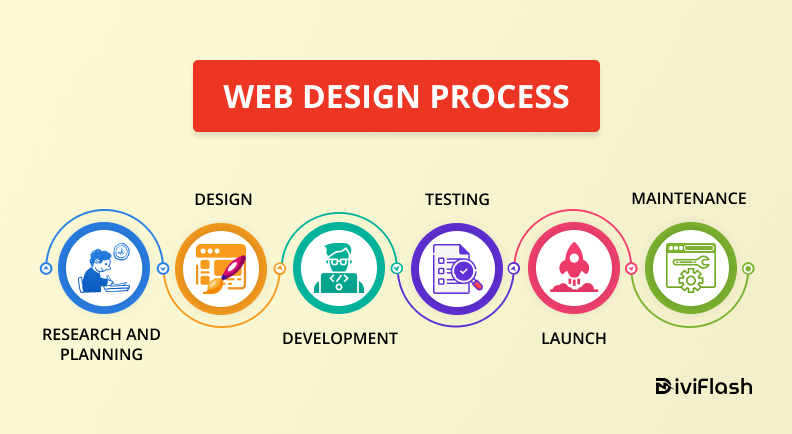Discover what to expect when working with a professional web agency to design a high-quality website.
Learn about the stages of web design, from discovery and wireframing to development and ongoing support, with a professional web agency.
Building a website is more than just picking a design and hitting publish—it’s a strategic process that involves planning, collaboration, and careful execution. When you work with a professional web agency, you gain access to a team of experts who guide you through each step of the process to create a website that aligns with your goals and vision. In this article, we’ll walk you through the key stages of designing a website with a professional web agency, and what you can expect at each stage.
Discovery and Strategy Sessions
The first step in the web design process is understanding your business, audience, and goals. This is where discovery and strategy sessions come into play.
- Understanding Your Business and Audience: The agency will start by asking questions about your business, target audience, and objectives for the website. This helps them align the design strategy with your brand and goals.
- Defining the Project Scope: Based on these insights, the agency will outline the project scope, including key deliverables, timelines, and expectations.
Why It Matters: A well-defined strategy ensures that the project remains focused and aligned with your business’s objectives.
Pro Tip: Be open and transparent about your goals, preferences, and any specific features you want for your website.
Wireframing and Prototyping
Once the strategy is in place, the next step is to create wireframes and prototypes that serve as blueprints for your website.
- Creating Wireframes: Wireframes are basic visual guides that outline the layout and structure of each page. They focus on the placement of key elements like headers, navigation, and CTAs.
- Developing Interactive Prototypes: Prototypes go a step further by providing interactive versions of the wireframes. This allows you to see how the website will function and navigate between pages.
Why It Matters: Wireframes and prototypes help identify potential design issues early in the process, saving time and effort down the line.
Pro Tip: Review the wireframes carefully and provide feedback on any changes or adjustments you want to make.
Design, Development, and Testing
With the wireframes and prototypes approved, the agency will move on to the design and development phase, followed by thorough testing.
- Designing the Visual Elements: The design team will create the visual elements of the website, including colours, fonts, images, and animations. This is where the website starts to take shape.
- Building the Website: The development team will then turn the design into a fully functional website. This involves coding, integrating content, and adding features like contact forms and social media links.
- Testing for Functionality and Performance: Before launch, the agency will conduct extensive testing to identify and fix any issues. This includes checking for broken links, testing responsiveness, and ensuring fast load times.
Why It Matters: A well-executed design and development process results in a polished and professional website.
Pro Tip: Request a staging site to review and test the website before it goes live.
Choosing the Right Platform for Your Website
When designing a website, one crucial decision is selecting the right platform to build it on. Whether you choose a popular content management system (CMS) like WordPress, an e-commerce platform such as Shopify, or a custom-built solution, each option comes with its own set of benefits and challenges. Your choice should depend on your business needs, goals, and technical expertise.
- WordPress for Versatility and Ease of Use: WordPress is an excellent choice for businesses looking for a versatile platform with a vast range of plugins and themes. It’s perfect for everything from blogs and service-based websites to more complex solutions.
- Shopify for E-commerce Success: If you’re running an online store, Shopify offers robust features designed specifically for e-commerce. It provides tools for managing products, payments, and shipping all in one place.
By choosing the right platform, you can build a website that aligns with your goals and meets the expectations of your customers.
Launch and Ongoing Support
The final stage is launching your website and providing ongoing support to ensure its continued success.
- Launching the Website: Once the site has passed all tests, it’s ready to go live. The agency will handle the technical aspects of launching the website, ensuring a smooth transition.
- Providing Ongoing Support and Maintenance: After the launch, the agency may offer ongoing support and maintenance services to keep your site updated and secure.
Why It Matters: A successful launch and ongoing support ensure that your website remains in peak condition and continues to perform well.
Pro Tip: Establish a post-launch plan with your agency to cover updates, backups, and any future changes you may need.
Conclusion
Designing a website with a professional web agency is a collaborative and strategic process that involves discovery, wireframing, design, development, and ongoing support. By working with experienced professionals, you can create a website that not only meets your goals but also provides a seamless user experience. Remember, a successful website isn’t just built—it’s carefully crafted.
Looking for a professional web agency to help design your website? Contact Web Momentum today to discuss your project and find out how we can bring your vision to life.
About the Author
Web Momentum is a creative web design and digital marketing agency based in Reading, Berkshire. Looking for web design Reading? With over 15 years of experience, we specialise in bespoke web design, SEO, and digital marketing services tailored to small businesses. Our mission is to help businesses succeed online and achieve measurable results.
